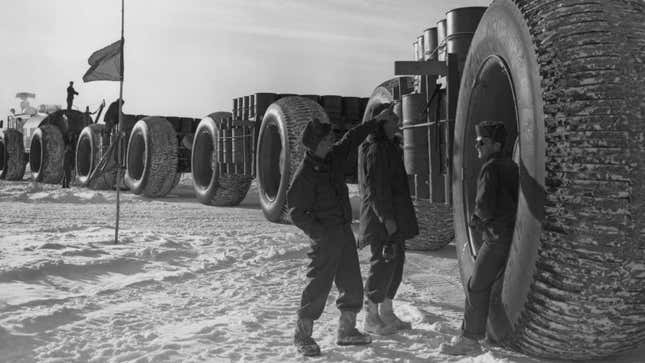The U.S. army has spent a lot cash creating stuff over time. It had super-secret spy planes, tried to practice dolphins for underwater warfare and even had the good concept of creating flying plane carriers. Nonetheless, one if its greatest concepts may be this ridiculous snow practice that was designed to overcome the Arctic.
The U.S. military had a couple of experimental craft within the works within the Nineteen Fifties, chief amongst them was a brand new sort of street practice that would haul huge hundreds round locations the place roads had been tough, scarce or non-existent. These experimental craft included the longest automobile ever, an overland practice created to restock nuclear silos and this, the LCC-1 Sno-Practice.
Designed to function in a few of the most excessive environments round, the LCC-1 was first delivered to our consideration through the superb YouTuber Calum, who constructed a reputation for himself uncovering some fairly spectacular forgotten machines.
The LCC-1, which implies Logistics Cargo Provider primary, was developed by the U.S. military in cahoots with Texas-based heavy tools producer LeTourneau, Calum defined in a current add. It comprised an infinite engine up entrance that housed a heated space for its operators in addition to the 600 horsepower diesel motor that it wanted to tow massive military stuff round.
With that energy unit, the Sno-Practice may tow three trailer automobiles that might be piled up with a mixed load of round 45 tons of army gear. That’s a reasonably spectacular haul, nevertheless it’s not almost as spectacular as the large wheels that this factor was working round on.
As a way to higher distribute its weight throughout the sorts of frozen surfaces the Sno-Practice was designed for, it ran on a set of customized Firestone tires that had been big, actually big. In response to Overland Trains, the automobile used Firestone 120x48x68 tires, that means they measured greater than 10 ft tall and 4 ft huge. These huge wheels had been excellent for the frozen wastes of Greenland, the place the LCC-1 was deployed by the U.S. army from 1956.
The LCC-1 is the third overlanding practice that Calum has explored on his channel, however he calls this one essentially the most profitable of the interval, because it actually did show its price in service over time.
It was steadily used to hold hundreds to Camp Century, an Arctic analysis base operated by the U.S. till 1967. The Sno-Practice additionally served in Alaska, the place it was used to resupply the Early Warning Line community of radar detectors throughout Canada and the U.S.

The huge machine was even stated to have saved somebody’s life throughout a storm, providing a toddler with appendicitis the one path to hospital because of its rugged capabilities. That go-anywhere perspective additionally meant the Sno-train was referred to as on to rescue one other large overlanding practice that had gotten caught within the Arctic within the early ’60s. What a machine.
Nonetheless, all that off-road expertise wasn’t sufficient to maintain the Sno-Practice in service, and it was taken out of service in 1962. Now, the remnants of the Sno-Practice will be discovered on the Yukon Transportation Museum in Whitehorse, Yukon, the place it survives alongside a number of of its trailers nonetheless full with the unique 10-foot tires. It’s fairly the location.


